Semarang
 Semarang city, the capital of Central Java province is located
on the north Coast of Java Sea. Semarang is situated on Java's northern
coast and is called the capital of Central Java, as it lies just about
halfway between the extreme east and west coasts of the island. From
Candi Hill we get amazing scenery of the port, the lowlands and green
paddy fields, the city itself and the surrounding mountains. The
environs around Semarang are perfect for clay trips side-excursions.
Semarang is the five major cities in the nation. It is situated on
Java's normally flat northern coast and appropriately called the capital
of Central Java.
Semarang city, the capital of Central Java province is located
on the north Coast of Java Sea. Semarang is situated on Java's northern
coast and is called the capital of Central Java, as it lies just about
halfway between the extreme east and west coasts of the island. From
Candi Hill we get amazing scenery of the port, the lowlands and green
paddy fields, the city itself and the surrounding mountains. The
environs around Semarang are perfect for clay trips side-excursions.
Semarang is the five major cities in the nation. It is situated on
Java's normally flat northern coast and appropriately called the capital
of Central Java.Semarang is a busy administrative and trading city, most of the offices, business centers, industrial estates are concentrated in the low land, where as in the hilly side, there are many houses with the beautiful gardens with a superb view to the town and the sea. The old records of this city date back to the 15th to the 18th century AD in where captivating ancient and colonial monuments still standing to present date.
There is an older part of the city, close to its ocean harbor, where we can still find an interesting collection of odd-looking buildings dating back to the Dutch colonial era and further back still, to the time of the Dutch East Indies Company. The old city has colonial era buildings (Dutch) and is well worth a stroll. If have time we can try and catch a traditional Wajang puppet performance.
The population of Semarang is predominantly Javanese, though with smaller numbers of people from many regions in Indonesia. The city is known for its large ethnically Chinese population. The main languages spoken are Indonesian and Javanese. As a result of its large ethnically Chinese population, the city boasts several Chinese temples. These include Sam Po Kong (Kedung Batu), built in honor of the Chinese Great Admiral Zheng He who visited the area in 1405, and Tay Kak Sie Temple. Blenduk Church, a 1753 Protestant church built by Dutch, is located in the old town (called "Oudstad"). Tugu Muda (Youth Monument), a monument to heroes of Indonesia's independence struggle, is located in front of Lawang Sewu Building, at the end of Pemuda Street, one of the city's major shopping streets.
Magelang
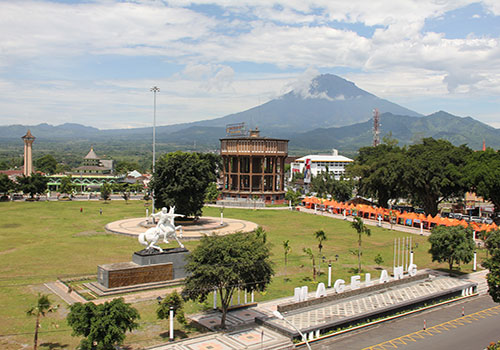 Magelang Regency as a regency in Central Java is located between
other regencies and municipalities such as Temanggung Regency, Semarang
Regency, Boyolali Regency, Purworejo Regency, Wonosobo Regency,
Magelang Municipality and DIY, stretches along the equator between
110001'51” and 110026'58” East Longitude and between 7019'13” and
7042'16” South Latitude. Magelang is a cool pleasant medium sized city
about 40 Km north of Yogya, surrounded by several mountains; Merapi and
Merbabu in the east, Sumbing and Sindoro in the west. It is located on
the road connecting Yogya and Semarang on the west site, whereas the
other east site is Yogya - Solo - Semarang. Magelang is a pleasant major
Central Java town of medium size, about sixty-four kilometers from
Wonosobo. Magelang town is also the capital of Magelang municipality,
which covers an area of 18,12 square kilometers. It consists of two
districts and fourteen villages. It is known, besides for its pleasant
climate and beautiful surroundings, for the facts that the Indonesia
National Military Academy is located here.
Magelang Regency as a regency in Central Java is located between
other regencies and municipalities such as Temanggung Regency, Semarang
Regency, Boyolali Regency, Purworejo Regency, Wonosobo Regency,
Magelang Municipality and DIY, stretches along the equator between
110001'51” and 110026'58” East Longitude and between 7019'13” and
7042'16” South Latitude. Magelang is a cool pleasant medium sized city
about 40 Km north of Yogya, surrounded by several mountains; Merapi and
Merbabu in the east, Sumbing and Sindoro in the west. It is located on
the road connecting Yogya and Semarang on the west site, whereas the
other east site is Yogya - Solo - Semarang. Magelang is a pleasant major
Central Java town of medium size, about sixty-four kilometers from
Wonosobo. Magelang town is also the capital of Magelang municipality,
which covers an area of 18,12 square kilometers. It consists of two
districts and fourteen villages. It is known, besides for its pleasant
climate and beautiful surroundings, for the facts that the Indonesia
National Military Academy is located here.The city has historically been a military post, dating back to the Dutch East Indies colonial era. It subsequently acted as an army stronghold for Indonesia pro-independence movement against the Dutch government during the resistance period. Currently, it is host to two military landmarks: The National Military Academy, and the only military-associated school, Taruna Nusantara.
Solo
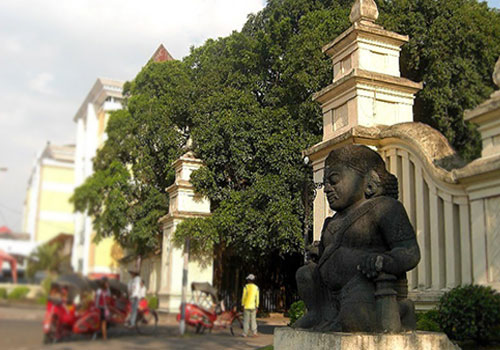 Surakarta or more famous as Solo is lying across in fertile
plain terrain along the longest river in Java, Bengawan or River Solo.
Flanked by mountain volcanoes Merapi and Merbabu in the north, and mount
Lawu in the southeast border, is famous as a stronghold and center of
Javanese culture and tradition. Surakarta, is the cradle of Javanese
culture, with two royal houses in one single city: the Kraton of Solo
and the Mangkunegaran, a principality. Descendants of these two royal
houses are still considered leaders of Javanese culture and traditions.
Majestic ceremonies and royal festivals are still held with great
affectation nowadays. Surakarta or Solo (550000 inhabitants) draws its
name from the longest river of Java, which passes in this city. It was
the capital of the kingdom of Mataram from 1745 to 1755. There are many
Becak (rickshaws decorated with naive scenes) croos the city.
Surakarta or more famous as Solo is lying across in fertile
plain terrain along the longest river in Java, Bengawan or River Solo.
Flanked by mountain volcanoes Merapi and Merbabu in the north, and mount
Lawu in the southeast border, is famous as a stronghold and center of
Javanese culture and tradition. Surakarta, is the cradle of Javanese
culture, with two royal houses in one single city: the Kraton of Solo
and the Mangkunegaran, a principality. Descendants of these two royal
houses are still considered leaders of Javanese culture and traditions.
Majestic ceremonies and royal festivals are still held with great
affectation nowadays. Surakarta or Solo (550000 inhabitants) draws its
name from the longest river of Java, which passes in this city. It was
the capital of the kingdom of Mataram from 1745 to 1755. There are many
Becak (rickshaws decorated with naive scenes) croos the city.Solo offers an incredible list of eateries also popular far beyond the city. Solo today remains a distinctly Central Javanese with an elegance all its own. It is one of the centers of batik and other Javanese fabrics, and souvenir hunters may find exquisite 'objects d'art" and ornate trinkets in the local markets. Those interested in old, Javanese culture and art should not miss Solo. Solo is called the city that never sleeps. From the evening throughout the whole night one can always find something to eat or buy, as vendors of all kinds as well as small food-stalls remain active and open 24 hours. Home of two royal houses with centuries of power and influence over the city. There are nice inns and hotels in Selo for accommodation. This place was a famous holiday resort of Surakarta Royal Families.
Solo is Surakarta's commercial as well as its administrative center, and produce from the surrounding desa fills the markets every day. Solo produces cigarettes, herbal medicines and various other light industry products, but batik is far and away the most important manufacturing activity in the city. Batik is a traditional textile working process involving the use of wax to cover the cloth in patterns and thus control the areas affected by dying. In the traditional process, batik tulis ("written batik") hot wax is applied with incredible patience and skill with an instrument that looks like a pipe but is used like a pen. The women and girls sit circled around an often-smoky little burner that heats the wax.
Many of the larger houses participate in the batik industry, with an area set aside for a covey of from 10 to 30 women and girls, who usually come from the village (desa). Really skilled workers are generally old, and the present level of batik production is not likely to continue in economically developing Java as alternative, less demanding activities absorb more of this cheap labor.
Karimunjawa
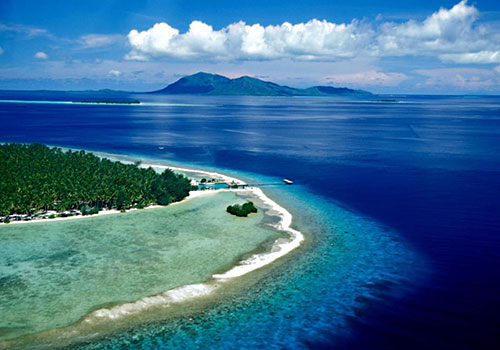 Karimunjawa is and island chain stretching in a northwesterly
direction 83 km from Jepara. Central Java. This archipelago is a cluster
of 27 islands in the java sea. Only seven of the islands are inhabited.
The reefs are a mixture of fringing, barrier, and patch with bottom
depths ranging from 15 to 40 meters. The name of Karimunjawa is taken
from Javanese language 'Kremun kremun saking tanah Jawi' addressed by
one of Wali Songo (the Nine Saints who had introduced Islam in Java) to
describe how far this mini archipelago from Java, to be exact from
Semarang and Jepara. Stands from 27 islands, this mini archipelago
became marine national park and it's like a treasure for those who love
marine life. Here can be found protected coral reefs (very colorful
plateaus and plains in deep and shallow waters), secluded and tranquil
white beaches, pelican and hornbill, sea grass and kinds of sea
creatures, from crabs, anchovy, starfish, sharks, stingray, jellyfish,
red snappers, etc.
Karimunjawa is and island chain stretching in a northwesterly
direction 83 km from Jepara. Central Java. This archipelago is a cluster
of 27 islands in the java sea. Only seven of the islands are inhabited.
The reefs are a mixture of fringing, barrier, and patch with bottom
depths ranging from 15 to 40 meters. The name of Karimunjawa is taken
from Javanese language 'Kremun kremun saking tanah Jawi' addressed by
one of Wali Songo (the Nine Saints who had introduced Islam in Java) to
describe how far this mini archipelago from Java, to be exact from
Semarang and Jepara. Stands from 27 islands, this mini archipelago
became marine national park and it's like a treasure for those who love
marine life. Here can be found protected coral reefs (very colorful
plateaus and plains in deep and shallow waters), secluded and tranquil
white beaches, pelican and hornbill, sea grass and kinds of sea
creatures, from crabs, anchovy, starfish, sharks, stingray, jellyfish,
red snappers, etc.The Marine National Park Karimun Jawa is 110,000 ha and lies 90 km north east of Jepara in Central Java. We will find mangrove forest and beach forest. The park is named after the largest island Karimun Jawa. The vegetation consists mainly of mangrove and beach forest, although there is some lowland rain forest on Karimun Jawa. Most of the islands are surrounded by sandy beaches and fringing coral reefs. Fresh water is confined to a few small wells and forest streams on Karimun Jawa. A number of endemic animals live on the island while on the beaches sea turtles lay their eggs. The average tidal range is 92 cm.
The archipelagic Karimunjawa, thought not as known the Marine reserves near Ambon and Manado, has unexpectedly good beaches, reefs and lovely sea scopes. Corals seem to blossom in to gardens, with an Amazing variety of form and color fishers and marine plants. It lies 90 km away from Jepara and can reached by "KM. Adison I & KM Kota Ukir" boat, the only ferryboat connecting Karimunjawa and Jepara. The resort offers stunning dives and snorkeling trips for all sorts of divers from novice to experience. Fringing reefs, atolls, wrecks and an excellent variety of different species make diving in Karimunjawa an unforgettable adventure.
Borobudur Temple
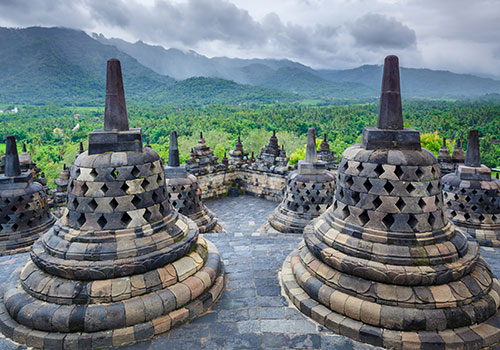 Borobudur is the biggest Buddhist temple in the ninth century
measuring 123 x 123 meters. It is located at Magelang, 90-km southeast
of Semarang, or 42-km northwest of Yogyakarta. Borobudur temple is the
one of the best-preserved ancient monument in Indonesia that are most
frequently visited by over a million domestic as well as foreign
visitors. It also had been acclaimed by the world as a cultural heritage
main kind. The architectural style has no equal through out the world.
It was completed centuries before Angkor Wat in Kamboja. Borobudur is
one of the world's most famous temples; it stands majestically on a
hilltop overlooking lush green fields and distant hills. Borobudur is
built of gray andesite stone. It rises to seven terraces, each smaller
than the one below it. The top is the Great Stupa, standing 40 meters
above the ground. The walls of the Borobudur are sculptured in
bas-reliefs extending over a total length of six kilometers. It has been
hailed as the largest and most complete ensemble of Buddhist relieves
in the world, unsurpassed in artistic merit and each scene an individual
masterpiece.
Borobudur is the biggest Buddhist temple in the ninth century
measuring 123 x 123 meters. It is located at Magelang, 90-km southeast
of Semarang, or 42-km northwest of Yogyakarta. Borobudur temple is the
one of the best-preserved ancient monument in Indonesia that are most
frequently visited by over a million domestic as well as foreign
visitors. It also had been acclaimed by the world as a cultural heritage
main kind. The architectural style has no equal through out the world.
It was completed centuries before Angkor Wat in Kamboja. Borobudur is
one of the world's most famous temples; it stands majestically on a
hilltop overlooking lush green fields and distant hills. Borobudur is
built of gray andesite stone. It rises to seven terraces, each smaller
than the one below it. The top is the Great Stupa, standing 40 meters
above the ground. The walls of the Borobudur are sculptured in
bas-reliefs extending over a total length of six kilometers. It has been
hailed as the largest and most complete ensemble of Buddhist relieves
in the world, unsurpassed in artistic merit and each scene an individual
masterpiece.Borobudur temple built in the eighth century by the Cailendra dynasty, is believed to have been derived from the Sanskrit words "Vihara Buddha Uhr" the Buddhist Monastery on the hill. Borobudur is a terraced temple surmounted by stupas, or stone towers; the terraces resemble Indonesian burial foundations, indicating that Borobudur was regarded as the symbol of the final resting place of its founder, a Syailendra, who was united after his death with the Buddha. The Prambanan temple complex is also associated with a dead king. The inscription of 856 mentions a royal funeral ceremony and shows that the dead king had joined Shiva, just as the founder of the Borobudur monument had joined the Buddha. Divine attributes, however, had been ascribed to kings during their lifetimes. A Mahayana inscription of this period shows that a ruler was said to have the purifying powers of a bodhisattva, the status assumed by the ruler of Shrivijaya in the 7th century; a 9th-century Shaivite inscription from the Kedu Plain describes a ruler as being "a portion of Shiva."
The Borobudur was in danger of collapsing as its stone statues and stone cancer, moss and lichen affected bas-reliefs. But, the monument has been completely restored and was officially opened by the President on 23rd February 1983. The restoration took eight years to complete, funded by the Government of Indonesia with aid from the UNESCO and donations from private citizens as well as from foreign governments.
The visitors have the option of going by taxi or public bus to reach this temple. Public transportation is available from the bus terminal. From that point visitors can hire becaks or horse carts, or walk the rest of the way to the monument. A large parking area is available not far from the monument, so private cars and buses can park in this area.
Bandungan and Gedong Songo Temple
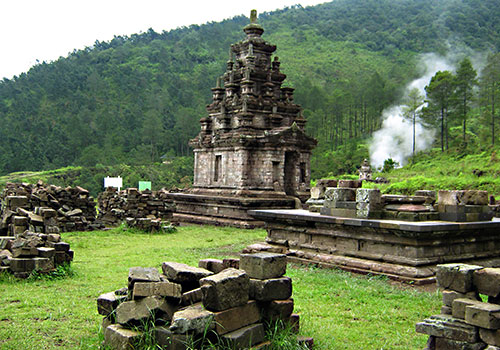 This is a resort on the slope of mount Ungaran, about 900 meters
above sea level. Gedong Songo (nine buildings), a group of small 8th
century Hindu Javanese temples, can be reached either by car or on
horseback from the town. Built at about the same time as the temples of
the Dieng complex, Gedong Songo is one of the most beautifully sited
temple complexes in Central Java and the views alone are worth the trip.
Gedung Songo ('Nine Buildings') belong to the earliest antiquities of
Java, they follow up the temples on the Dieng Plateau directly, for what
about time. They were also built high in the mountains in an area full
with volcanic activity; and they were also from Hinduist origin. But
where the temples on Dieng Plateau are somewhat squeezed into a foggy
valley, Gedung Songo are spread over the higher parts of the mountains,
which guarantee a splendid view. On clear days, the horizon is one long
row of volcanoes, from mount Lawu in the east, towards mount Sumbing,
mount Sundoro and Dieng Plateau in the west.
This is a resort on the slope of mount Ungaran, about 900 meters
above sea level. Gedong Songo (nine buildings), a group of small 8th
century Hindu Javanese temples, can be reached either by car or on
horseback from the town. Built at about the same time as the temples of
the Dieng complex, Gedong Songo is one of the most beautifully sited
temple complexes in Central Java and the views alone are worth the trip.
Gedung Songo ('Nine Buildings') belong to the earliest antiquities of
Java, they follow up the temples on the Dieng Plateau directly, for what
about time. They were also built high in the mountains in an area full
with volcanic activity; and they were also from Hinduist origin. But
where the temples on Dieng Plateau are somewhat squeezed into a foggy
valley, Gedung Songo are spread over the higher parts of the mountains,
which guarantee a splendid view. On clear days, the horizon is one long
row of volcanoes, from mount Lawu in the east, towards mount Sumbing,
mount Sundoro and Dieng Plateau in the west.The temples were built between 730 and 780, the first temple excepted, which could have been built some 30 years later. Gunung Songo is not the original name and also doesn't point at the number of structures. The number nine has a special meaning in the Javanese culture, in which there is a strong attachment to numbers. The temples are located at about the same distance from each other (100 meters, 200 meters) on a naturally formed terrace of edge of a mountain.
Ambarawa Railway Museum
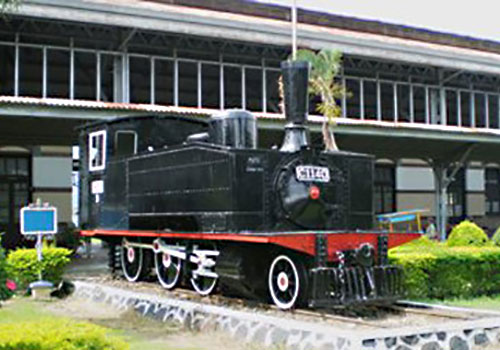 Ambarawa is famous nationwide by the credo Palagan Ambarawa.
Small city that forgotten nowadays but became one of the important base
camp of National heroes during Dutch occupancy in World War II. A small
city in the junction of national road between Yogyakarta to Semarang and
accessible to several small cities nearby like Salatiga, Magelang and
Bandungan. Fifty km south of Semarang, Ambarawa has locomotives of
various types and ages, and it is still possible to ride on a cog
railway between Ambarawa and Bedono, a village nearby. Ambarawa Railway
Museum 50 km south of Semarang, Ambarawa is the home of Java's antique
locomotives, housed in a museum. Prior arrangements should be made for
groups. Also of interest are a collection of antique telephones and
other instrument used for railway communication.
Ambarawa is famous nationwide by the credo Palagan Ambarawa.
Small city that forgotten nowadays but became one of the important base
camp of National heroes during Dutch occupancy in World War II. A small
city in the junction of national road between Yogyakarta to Semarang and
accessible to several small cities nearby like Salatiga, Magelang and
Bandungan. Fifty km south of Semarang, Ambarawa has locomotives of
various types and ages, and it is still possible to ride on a cog
railway between Ambarawa and Bedono, a village nearby. Ambarawa Railway
Museum 50 km south of Semarang, Ambarawa is the home of Java's antique
locomotives, housed in a museum. Prior arrangements should be made for
groups. Also of interest are a collection of antique telephones and
other instrument used for railway communication.The museum was established in the 1970s primarily to preserve a wide selection of the steam locomotives, which were then coming to the end of their useful lives on the 3ft 6in (1067mm) gauge railways of the Indonesian State Railway (the Perusahaan Negara Kereta Api, PNKA). These are parked in the open air next to the original station, originally a transhipment point between the 4ft 8 in gauge branch from Kedungjati to the northeast and the 3ft 6in gauge line onward towards Yogyakarta via Magelang to the south. It is still possible to see that the two sides of the station were built to accommodate different size trains. Ambarawa lays some way above sea level and was an administrative centre for the Dutch colonialists. Now the provincial Government of Central Java is increasingly taking an interest from the point of view of its heritage significance and its potential as a tourist attraction. Non-Governmental bodies like the Semarang Heritage Society are also acting to assist and there is also an unofficial overseas group 'The Friends of Ambarawa Railway Museum'.
Sangiran
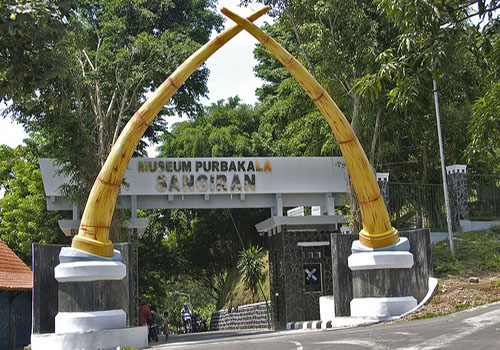 Sangiran is located 15 km from Surakarta. It is a village
located 17 Km north of Solo, on the road to Purwodadi. It is an
important place for Pithecanthropus Erectus, the pre-historic Java man.
It is fossilized land of prehistoric living things. The Pleistocene
Museum keeps some skills of the erectus, fossils of plants and animals.
Sangiran and other places such as Wajak (near Tulungangung) and Trinil
(near Ngawi) are significant places for human evolution/theory. It is
interesting place for scientific tourism in the field of geology,
anthropology and archeology. Many experts came to this site to do some
research and study among other; Van Es (1939), Duyfyes (1936), Van
Bemmelen (1937), Van Koeningswald (1938), Sartono (1960), Suradi (1962)
and Otto Sudarmaji (1976). Van Koeningswald said that more than five
different types of hominoid fossils have been found in Sangiran, it was
incredible. There is no other place in the world like Sangiran. The
Sangiran fossils are very various, they were earth as well as sea
fossils. There was a possibility that island of Java was erected from
the bottom of sea million years ago.
Sangiran is located 15 km from Surakarta. It is a village
located 17 Km north of Solo, on the road to Purwodadi. It is an
important place for Pithecanthropus Erectus, the pre-historic Java man.
It is fossilized land of prehistoric living things. The Pleistocene
Museum keeps some skills of the erectus, fossils of plants and animals.
Sangiran and other places such as Wajak (near Tulungangung) and Trinil
(near Ngawi) are significant places for human evolution/theory. It is
interesting place for scientific tourism in the field of geology,
anthropology and archeology. Many experts came to this site to do some
research and study among other; Van Es (1939), Duyfyes (1936), Van
Bemmelen (1937), Van Koeningswald (1938), Sartono (1960), Suradi (1962)
and Otto Sudarmaji (1976). Van Koeningswald said that more than five
different types of hominoid fossils have been found in Sangiran, it was
incredible. There is no other place in the world like Sangiran. The
Sangiran fossils are very various, they were earth as well as sea
fossils. There was a possibility that island of Java was erected from
the bottom of sea million years ago.In 1891, Eugene Dubois, a French anthropologist discovered fossils of Pithecanthropus Erectus, the oldest Java man known. Again in 1930 and 1931, Ngandong Village, Trinil-Mojokerto, was marked with the discovery of fossils of a man that belonged to the Pleistocene Period. It revealed human history from many centuries ago. Prof. Dr. Van Koenigswald in 1936 found more evidence about human evolution. He discovered some fossils that support the theory of human growth from an ape-man to be man as we are now. Other fossils including those of mammoths (prehistoric elephant) are now preserved in the Bandung Geological Museum. In mid 1980, the finding of a complete 4 m tall elephant startled scientists. Nowadays, the villagers of Sangiran are making souvenirs from stones such as statues, axes, eggs, rings, etc to promote tourism.
Jatijajar Cave
 Jatijajar cave is located about 49 km west of Kebumen, or 20 km
from Gombong. It is the most interesting cave in Central Java with its
stalactite and stalagmite. Inside the cave, there is Kamandaka statue,
which has its own legend. The legend inside the cave describing about
the legend of Raden Kamandaka or lutung kasarung legend, which this
story is represented by statues inside of cave. It is believe that water
from water source inside cave can make some one well preserved. The
length of this cave is about 250 meters. To reach the location there is
available transportation such as angkot (a small bus), and also some
representative hotels and restaurants. The name of Jatijajar is come
when there were two of twin jati trees growths in mouth of cave in the
first time founded. The cave complex is equipped by Dinosaurs statue
discharges water from his mouth, whereas water comes from sources inside
cave every day. There are also another beautiful cave in the area of
Jatijajar cave, such as, Intan Cave and Dempok cave completed by a
pleasure park Also there is park available, with the name Taman Kera as
many of monkey statues in there. Inside mouth of cave there are many
stalactites and stalagmites, a natural process since thousands years
ago.
Jatijajar cave is located about 49 km west of Kebumen, or 20 km
from Gombong. It is the most interesting cave in Central Java with its
stalactite and stalagmite. Inside the cave, there is Kamandaka statue,
which has its own legend. The legend inside the cave describing about
the legend of Raden Kamandaka or lutung kasarung legend, which this
story is represented by statues inside of cave. It is believe that water
from water source inside cave can make some one well preserved. The
length of this cave is about 250 meters. To reach the location there is
available transportation such as angkot (a small bus), and also some
representative hotels and restaurants. The name of Jatijajar is come
when there were two of twin jati trees growths in mouth of cave in the
first time founded. The cave complex is equipped by Dinosaurs statue
discharges water from his mouth, whereas water comes from sources inside
cave every day. There are also another beautiful cave in the area of
Jatijajar cave, such as, Intan Cave and Dempok cave completed by a
pleasure park Also there is park available, with the name Taman Kera as
many of monkey statues in there. Inside mouth of cave there are many
stalactites and stalagmites, a natural process since thousands years
ago.Bledug Kuwu
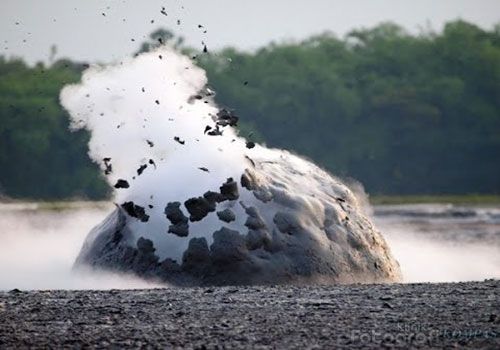 Bledug Kuwu is one of tourist attractions in Wirosari area in
Grobogan Region, Purwodadi, Central Java. Bledug Kuwu is a local name
for something that burst in pool. This is rather strange pool that far
from volcano. The vapor burst came from carbon dioxide release. The
temperature is mild. Visitors might experience a stunning natural
occurrence of small, frequent bursts from mud crate with a sound
resembling a mount eruption. This natural phenomenon is resulted from
geothermal motion inside the earth bed. Witness said that a big burst
could even create small quakes that quiver the area.
Bledug Kuwu is one of tourist attractions in Wirosari area in
Grobogan Region, Purwodadi, Central Java. Bledug Kuwu is a local name
for something that burst in pool. This is rather strange pool that far
from volcano. The vapor burst came from carbon dioxide release. The
temperature is mild. Visitors might experience a stunning natural
occurrence of small, frequent bursts from mud crate with a sound
resembling a mount eruption. This natural phenomenon is resulted from
geothermal motion inside the earth bed. Witness said that a big burst
could even create small quakes that quiver the area.Bledug Kuwu looks like just another muddy pond. But every one or two minutes, the placid water erupts in an explosion of mud, followed by a plume of white steam. The pond is located just off the alternative road connecting Purwodadi and Cepu in Central Java, on a site measuring some 4.5 hectares. Bledug Kuwu has become a tourist attraction in the area. The visitors can watch the geyser from a distance of between 10 meters and 20 meters. The eruptions of water and mud shift positions from time to time. But there are two spots where the geyser regularly erupts. The locals call the one in the east Mbah (Grandpa) Jokotua and the one in the west Mbah (Grandma) Rodenok. They have given the spots where the geyser erupts names, as they believe that the place is sacred.
Bengawan Solo River
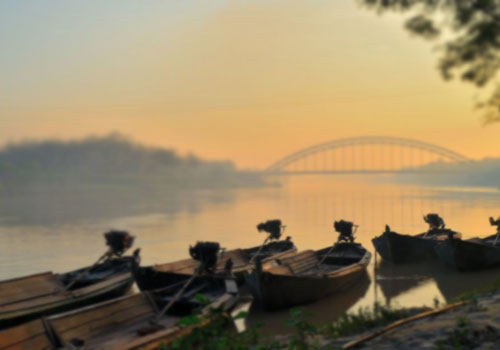 This longest river in Java flows along the eastern edge of the
town from its source in the lime stones hill of the south, near East
Java border to its mouth nearby Surabaya, on the Java sea. Regretfully,
the river is now shallow it is not navigable anymore. But in the past it
was an important link between Solo and the north cost of East Java. It
length is 600 km flowing in 2 provinces which are Central Java Province
and East Java Province with the irrigation width 16.000 km2, was the
biggest and the main river basin area. It rises on the slope of Mount
Lawu volcano (10,712 feet [3,265 m]) and the southern limestone range
(Sewu Mountains) and flows north, then east to discharge into the Java
Sea at a point opposite Madura Island, northwest of Surabaya. In recent
30 years development of irrigation facility at the Bengawan Solo river
area have reach a significant level of development. This was mark by the
completed of irrigation building, which still in progress or even have
been built such as reservoir, dam, dike, irrigation net, and others.
Investment have been spent to reach this development level is very big.
Those buildings have functions as a flood controller, Hydraulic Power
Generator, water supply for farming, industry, drink water, fishery, and
others.
This longest river in Java flows along the eastern edge of the
town from its source in the lime stones hill of the south, near East
Java border to its mouth nearby Surabaya, on the Java sea. Regretfully,
the river is now shallow it is not navigable anymore. But in the past it
was an important link between Solo and the north cost of East Java. It
length is 600 km flowing in 2 provinces which are Central Java Province
and East Java Province with the irrigation width 16.000 km2, was the
biggest and the main river basin area. It rises on the slope of Mount
Lawu volcano (10,712 feet [3,265 m]) and the southern limestone range
(Sewu Mountains) and flows north, then east to discharge into the Java
Sea at a point opposite Madura Island, northwest of Surabaya. In recent
30 years development of irrigation facility at the Bengawan Solo river
area have reach a significant level of development. This was mark by the
completed of irrigation building, which still in progress or even have
been built such as reservoir, dam, dike, irrigation net, and others.
Investment have been spent to reach this development level is very big.
Those buildings have functions as a flood controller, Hydraulic Power
Generator, water supply for farming, industry, drink water, fishery, and
others.There is a well-known song 'Bengawan Solo' composed by Mr. Gesang. In the central Javanese city of Solo, a statue of Gesang Martohartono looks over the gently flowing Bengawan Solo, or Solo River. It was the famous Indonesian singer-songwriter Gesang, who composed the celebrated Indonesian melody "Bengawan Solo" during World War II -- when the country was under Japanese occupation. The song describes the legendary river in a poetic and nostalgic way, that it is surrounded by mountains, its sources are near the city of Surakarta, that it ends in the sea, and that the merchant class always makes use of it. It is in the local Keroncong style, a popular folk style with influences from Portuguese. The Japanese, who occupied the country during World War II, brought the song with them to Japan after returning from the war. There, and also in the rest of Asia and later worldwide, the song became very famous.
Curug Semawur Waterfall
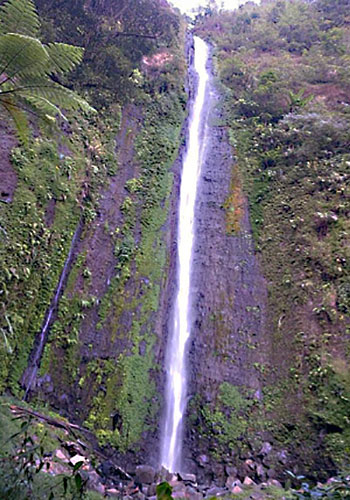 Curug Semawur, located at Blumah Village in Plantungan district,
Kendal, Central Java is about 33km from Semarang. The journey to the
waterfall can be a memorable experience as visitors would witness lines
of wooden-house of the villagers, in addition to encounters a bunch
monkeys along the way. Endless streams of waterfall heavily even in the
driest season of the year, not to mention its unusual height, which
could reach up to tens of meters. It has legend that the waterfall
actually consists of seven levels and very few people have been able to
climb up its peak.
Curug Semawur, located at Blumah Village in Plantungan district,
Kendal, Central Java is about 33km from Semarang. The journey to the
waterfall can be a memorable experience as visitors would witness lines
of wooden-house of the villagers, in addition to encounters a bunch
monkeys along the way. Endless streams of waterfall heavily even in the
driest season of the year, not to mention its unusual height, which
could reach up to tens of meters. It has legend that the waterfall
actually consists of seven levels and very few people have been able to
climb up its peak.Cipendok Waterfall
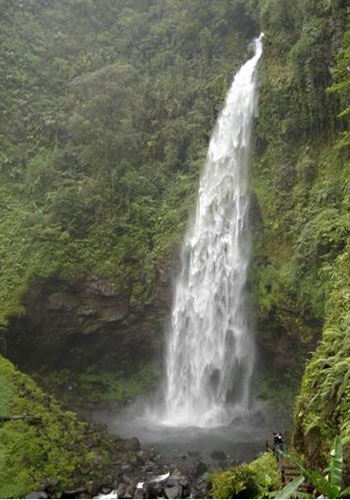 Cipendok waterfall is located at a plateau in Banyumas region
and officially made open for public in February 27, 1986 by the Banyumas
Regent, R.G Roydjito. Go north of Cipendok, lies the largest mountain
forest in Java. To be able to reach the bottom of Cipendok Waterfall we
must walk some steps down. In the stream at the feet of the waterfall,
there is a group of black, monstrous stones soaked by the heavy water.
Cipendok Waterfall is a perfect site for those who seek solace or quiet
surrounding for meditation.
Cipendok waterfall is located at a plateau in Banyumas region
and officially made open for public in February 27, 1986 by the Banyumas
Regent, R.G Roydjito. Go north of Cipendok, lies the largest mountain
forest in Java. To be able to reach the bottom of Cipendok Waterfall we
must walk some steps down. In the stream at the feet of the waterfall,
there is a group of black, monstrous stones soaked by the heavy water.
Cipendok Waterfall is a perfect site for those who seek solace or quiet
surrounding for meditation.Pasar Klewer (Klewer Market)
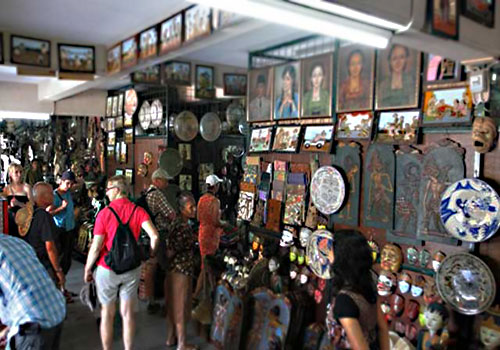 Off the west gate of Karaton's North Square, this old market
selling all kinds of fabrics, predominantly batik. Other traditional
fabrics are lurik (hand-woven striped cotton cloth) and tenun ikat.
There are hundreds of shops jammed along narrow passageways. The
visitors must be prepared to bargain. Batik cloths and garments,
hand-woven fabrics, traditional and local jewelry, leather puppets,
basketry, tortoise-shell accessories, trinkets, brassware and other
decorative items, and all kinds of antiques are local specialties.
Souvenir and art objects are available in all major towns of Central
Java, mostly in the downtown areas and popular market places or shopping
centers.
Off the west gate of Karaton's North Square, this old market
selling all kinds of fabrics, predominantly batik. Other traditional
fabrics are lurik (hand-woven striped cotton cloth) and tenun ikat.
There are hundreds of shops jammed along narrow passageways. The
visitors must be prepared to bargain. Batik cloths and garments,
hand-woven fabrics, traditional and local jewelry, leather puppets,
basketry, tortoise-shell accessories, trinkets, brassware and other
decorative items, and all kinds of antiques are local specialties.
Souvenir and art objects are available in all major towns of Central
Java, mostly in the downtown areas and popular market places or shopping
centers.Pasar Klewer in Solo is the busiest textile market in Java, a great place to buy not only the less expensive “stamped” (batik cap) cloths, but also some of the best hand-drawn batik tulis on the island. There are plenty of tailors in the market who can make shirts and skirts in a day. Also not to be missed while visiting Solo is the flea Market at Pasar Triwindu, where everything and anything is for sale to those willing to have a bit of fun bargaining.
Simpang Lima
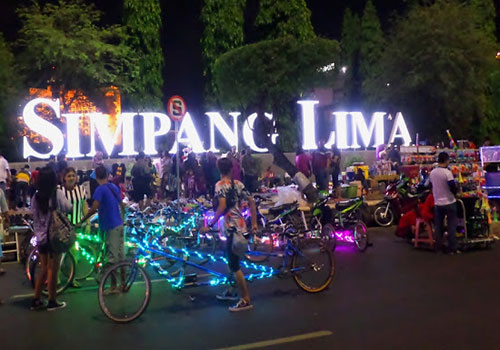 Simpang Lima (means "five intersection") is a vast field at the
heart of Semarang. At night, we can eat, drink or just bring our
self-wandering around Simpang Lima. There are plenty of food stalls
offering variety of Indonesian and Javanese food. The price is cheap,
sometimes very cheap. It is a square with many shops and cinemas around.
In the evening a lot of people are here taking a walk or
window-shopping. Early in the morning, people are jogging along the
street.
Simpang Lima (means "five intersection") is a vast field at the
heart of Semarang. At night, we can eat, drink or just bring our
self-wandering around Simpang Lima. There are plenty of food stalls
offering variety of Indonesian and Javanese food. The price is cheap,
sometimes very cheap. It is a square with many shops and cinemas around.
In the evening a lot of people are here taking a walk or
window-shopping. Early in the morning, people are jogging along the
street.Simpang Lima, the downtown of Semarang area, is probably the best place to stay if we want to enjoy the hustle bustle of the town life. However, if we are looking for tranquility, the hotels around Sisingamangaraja Street, the upscale neighborhood in the hills of Semarang is probably better.
Tidak ada komentar:
Posting Komentar